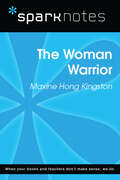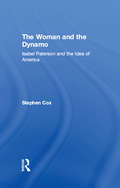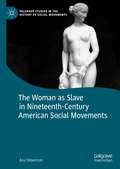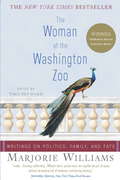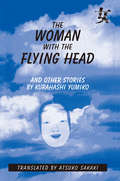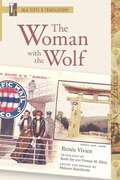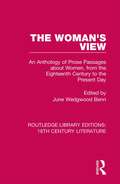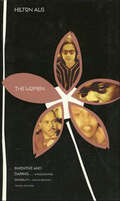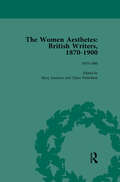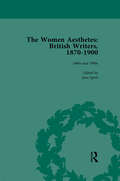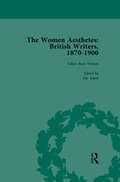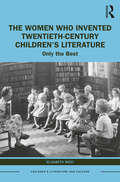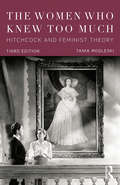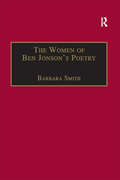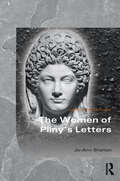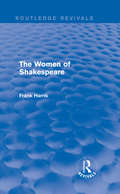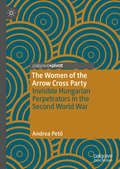- Table View
- List View
The Woman Warrior (SparkNotes Literature Guide Series)
by SparkNotesThe Woman Warrior (SparkNotes Literature Guide) by Maxine Hong Kingston Making the reading experience fun! Created by Harvard students for students everywhere, SparkNotes is a new breed of study guide: smarter, better, faster. Geared to what today's students need to know, SparkNotes provides: *Chapter-by-chapter analysis *Explanations of key themes, motifs, and symbols *A review quiz and essay topicsLively and accessible, these guides are perfect for late-night studying and writing papers
The Woman Who Pretended To Be Who She Was
by Wendy DonigerHow mistaken identity is used as a literary technique.
The Woman and the Dynamo: Isabel Paterson and the Idea of America
by Stephen CoxNovelist, columnist, cultural critic, political theorist-- Isabel Paterson was one of the most extraordinary personalities of the 1930s, renowned for her incisive wit and her unique interpretation of the American experience. The Woman and the Dynamo is the first biography of a woman who has long been a source of rumor and legend. From interviews, private papers, and her millions of published words, Stephen Cox weaves a narrative that brings Paterson vividly to life.A radical individualist in both theory and practice, Paterson spent her early life on the Western frontier, "lavished" two years on formal education, set a record for high-altitude flight, became a journalist by "accident," and made herself a fearless chronicler and conscience of New York literary life. At the same time, she made a permanent contribution to American political thought.Paterson identified the fundamental issues at stake in the crises of the twentieth century and responded with an original theory of history and political economy. In her view, the individual mind is the dynamo of history, working through the "long circuit" of institutions that maintain and enhance individual liberty; and America is the place where the advanced forms of those institutions were invented and are currently undergoing their severest trial. While other intellectuals derided the American ideal of progress and called for the restraint or abolition of the capitalist system, Paterson demanded a scrupulous application of the "engineering principles" on which American civilization had been built.The Woman and the Dynamo provides one of the few broad and detailed accounts of the origins of the American political Right, emphasizing the special role that women and imaginative writers played in its creation, and posing new questions about what it means to be "left" or "right," "liberal" or "conservative" in America. This will be compelling reading for those interested in twentieth century intellectual history, literature, and politics.
The Woman as Slave in Nineteenth-Century American Social Movements (Palgrave Studies in the History of Social Movements)
by Ana StevensonThis book is the first to develop a history of the analogy between woman and slave, charting its changing meanings and enduring implications across the social movements of the long nineteenth century. Looking beyond its foundations in the antislavery and women’s rights movements, this book examines the influence of the woman-slave analogy in popular culture along with its use across the dress reform, labor, suffrage, free love, racial uplift, and anti-vice movements. At once provocative and commonplace, the woman-slave analogy was used to exceptionally varied ends in the era of chattel slavery and slave emancipation. Yet, as this book reveals, a more diverse assembly of reformers both accepted and embraced a woman-as-slave worldview than has previously been appreciated. One of the most significant yet controversial rhetorical strategies in the history of feminism, the legacy of the woman-slave analogy continues to underpin the debates that shape feminist theory today.
The Woman at the Washington Zoo: Writings on Politics, Family, and Fate
by Marjorie WilliamsOne of Washington's finest writers on people, politics, and life ? collected for the first time.
The Woman with the Flying Head and Other Stories
by Kurahashi Yumiko Atsuko SakakiThis is an English-language anthology dedicated to the short stories of Kurahashi Yumiko (1935-), a Japanese novelist of profound intellectual powers. The eleven stories included in this volume suggest the breadth of the author's literary production, ranging from parodies of classical Japanese literature to cosmopolitan avant-garde works, from quasi-autobiography to science fiction. Her subversive fiction defies established definitions of "literature", "Japan", "modernity" and "femininity", and represents an important intellectual aspect of modern Japanese women's literature.
The Woman with the Flying Head and Other Stories (Japanese Women Writing Ser.)
by Kurahashi Yumiko Atsuko SakakiThis is an English-language anthology dedicated to the short stories of Kurahashi Yumiko (1935-), a Japanese novelist of profound intellectual powers. The eleven stories included in this volume suggest the breadth of the author's literary production, ranging from parodies of classical Japanese literature to cosmopolitan avant-garde works, from quasi-autobiography to science fiction. Her subversive fiction defies established definitions of "literature", "Japan", "modernity" and "femininity", and represents an important intellectual aspect of modern Japanese women's literature.
The Woman with the Wolf: An MLA Translation (Texts and Translations #36)
by Renée VivienAlthough Renée Vivien led a life of wealth and privilege in belle epoque Paris, she often felt like an outsider because she was attracted to other women. Financially secure, she wrote books to suit her own taste rather than that of the literary market. The Woman with the Wolf (La dame à la louve), from 1904, shows her at the height of her powers.These fierce, surprising stories challenge moral hypocrisy and normative views about gender, beginning with the title work, which offers a coded representation of same-sex love in the seemingly inexplicable commitment between a woman and her canine companion. The following stories feature a reimagined fairy tale in which Prince Charming turns out to be a young woman, a western adventure whose narrator goes mad with thirst, and other unconventional narratives that range across time and space.
The Woman's Page
by Janice FiamengoIn the late nineteenth and early twentieth centuries, journalism, politics, and social advocacy were largely male preserves. Six women, however, did manage to come to prominence through their writing and public performance: Agnes Maule Machar, Sara Jeannette Duncan, E. Pauline Johnson, Kathleen Blake Coleman, Flora MacDonald Denison, and Nellie L. McClung. The Woman's Page is a detailed study of these six women and their respective works.Focusing on the diverse sources of their rhetorical power, Janice Fiamengo assesses how popular poetry, journalism, essays, and public speeches enabled these women to play major roles in the central debates of their day. A few of their names, particularly those of McClung and Johnson, are still well known today, although studies of their writings and speeches are limited. Others are almost entirely unknown, an unfortunate fact given the wit, intelligence, and passion of their writing and self-presentation. Seeking to return their words to public attention, The Woman's Page demonstrates how these women influenced readers and listeners regarding their society's most controversial issues.
The Woman's View: An Anthology of Prose Passages about Women, from the Eighteenth Century to the Present Day (Routledge Library Editions: 18th Century Literature)
by June Wedgwood BennWhat is it like being a woman – in society, in the home and as a person in one’s own right? Originally published in 1967, here is a collection of passages, all linked by their theme, that of being a woman. They are taken from novels, essays, letters and diaries written by or about women concerning their psychology and position in society from the later eighteenth century onwards. In these days of emancipation and assumed equality (in some countries at any rate) it is as well to remember the very recent past and to look forward to the future, for all girls will have, certain problems to face just because they are girls. It is best to be prepared. The anthology was chosen and organised for girls who were taking English, either for General Studies or in preparation for University. The extracts cover a wide range of styles and periods, and were selected both as representative of their time and as good examples of prose. Love, sex, marriage, motherhood and the wider role of women in society are among the topics covered, and there is an ample list of suggestions for further readings, biographical notes on the writers and suggested questions for discussions or essay-writing.
The Wombats Go Wild for Words
by Beth FerryA trio of wandering wombats with a passion for words inspire an enthusiastic duckling to transform her town from dull to dazzling in this delectable picture book that shares with children the magic of words.Evergreen Forest is a very nice forest, with very nice trees and very nice animals. It&’s a rather dull place, but no one says a word about it. In fact, no one says very many words at all! And therein lies the problem.Until the word-loving wandering wombats arrive.They use words like enthusiastic and splendiferous, ready to turn ordinary into EXTRAordinary! With twinkles in their eyes and words on their minds, the word wombats come to transform Evergreen Forest. At first, the animals of Evergreen Forest are…confused. All except for a curious duckling who eagerly devours every noun, adjective, and verb that she hears. Slowly, the inhabitants of Evergreen Forest become mesmerized as they realize that words are not just fun, they are inspiring.New York Times bestselling author Beth Ferry and acclaimed illustrator Lori Nichols captivate readers with this dazzling, magnificent, and triumphant tale about discovering the power of words and the ways they connect and empower us.
The Women
by Hilton AlsA New York Times Notable BookDaring and fiercely original, The Women is at once a memoir, a psychological study, a sociopolitical manifesto, and an incisive adventure in literary criticism. It is conceived as a series of portraits analyzing the role that sexual and racial identity played in the lives and work of the writer's subjects: his mother, a self-described "Negress," who would not be defined by the limitations of race and gender; the mother of Malcolm X, whose mixed-race background and eventual descent into madness contributed to her son's misogyny and racism; brilliant, Harvard-educated Dorothy Dean, who rarely identified with other blacks or women, but deeply empathized with white gay men; and the late Owen Dodson, a poet and dramatist who was female-identified and who played an important role in the author's own social and intellectual formation.Hilton Als submits both racial and sexual stereotypes to his inimitable scrutiny with relentless humor and sympathy. The results are exhilarating. The Women is that rarest of books: a memorable work of self-investigation that creates a form of all its own.
The Women Aesthetes vol 1: British Writers, 1870-1900
by Jane Spirit Sue Asbee Mary Joannou Claire NicholsonThe aesthetic movement dominated the closing decades of the nineteenth century. It was significant for the role women played in it at a time when there were growing opportunities for them, both artistically and professionally. The material in this collection provides a representative selection of essays, fiction, poetry and drama by female authors.
The Women Aesthetes vol 2: British Writers, 1870-1900
by Jane Spirit Sue Asbee Mary Joannou Claire NicholsonThe aesthetic movement dominated the closing decades of the nineteenth century. It was significant for the role women played in it at a time when there were growing opportunities for them, both artistically and professionally. The material in this collection provides a representative selection of essays, fiction, poetry and drama by female authors.
The Women Aesthetes vol 3: British Writers, 1870-1900
by Jane Spirit Sue Asbee Mary Joannou Claire NicholsonThe aesthetic movement dominated the closing decades of the nineteenth century. It was significant for the role women played in it at a time when there were growing opportunities for them, both artistically and professionally. The material in this collection provides a representative selection of essays, fiction, poetry and drama by female authors.
The Women Who Invented Twentieth-Century Children’s Literature: Only the Best (Children's Literature and Culture)
by Elizabeth WestPublishing for children between 1930 and 1960 has been denigrated as a relatively fallow period for creativity and quality, certainly in comparison with the ‘golden ages’ of children’s literature that preceded and succeeded it. This book questions this perception by using archival evidence to argue that the work of what was predominantly a female group of editors, illustrators, authors and librarians (collectively referred to as bookwomen) resulted in many titles which are still considered as ‘classics’ today. The bookwomen reframed ideas about how children’s publishing should be approached and valued and, in doing so, laid the foundations for a subsequent generation of children’s authors and publishers who were to achieve far greater prominence. The key to the success of the bookwomen was their willingness to experiment, the strength of their relationships and their comprehensive understanding of the book production process. By focusing on a selection of women working across all aspects of the book production process, this book demonstrates that, both individually and collectively, women capitalised on their position as ‘other’ to the existing male institutions.
The Women Who Knew Too Much: Hitchcock and Feminist Theory
by Tania ModleskiOriginally published in 1988, The Women Who Knew Too Much remains a classic work in film theory and feminist criticism. The book consists of a theoretical introduction and analyses of seven important films by Alfred Hitchcock, each of which provides a basis for an analysis of the female spectator as well as of the male spectator. Modleski considers the emotional and psychic investments of men and women in female characters whose stories often undermine the mastery of the cinematic "master of suspense." The third edition features an interview with the author by David Greven, in which he and Modleski reflect on how feminist and queer approaches to Hitchcock studies may be brought into dialogue. A teaching guide and discussion questions by Ned Schantz help instructors and students to delve into this seminal work of feminist film theory.
The Women of Ben Jonson's Poetry: Female Representations in the Non-Dramatic Verse
by Barbara SmithBen Jonson (1572-1637) is recognised as one of the major poets and dramatists of his time. It is surprising, therefore, that this should be the first study to look specifically at the role of women in his poetry. Barbara Smith challenges previously held conceptions of Jonson as a misogynist, upholding the patronage system that allowed him to work. Through detailed examination of his poetic structures, the influence of Juvenal, Martial and Horace, and Jonson's attitudes to his own female patrons, the Countess of Bedford and Lady Mary Wroth, The Women of Ben Jonson's Poetry demonstrates how seventeenth century cultural values and ideas of gender are both supported and subverted in the poems. ’If we "survey Jonson in his works and know him there", we will find the independence of spirit and originality that made him a rarity in his time and ours.'
The Women of Brewster Place (SparkNotes Literature Guide Series)
by SparkNotesThe Women of Brewster Place (SparkNotes Literature Guide) by Gloria Naylor Making the reading experience fun! Created by Harvard students for students everywhere, SparkNotes is a new breed of study guide: smarter, better, faster. Geared to what today's students need to know, SparkNotes provides: *Chapter-by-chapter analysis *Explanations of key themes, motifs, and symbols *A review quiz and essay topicsLively and accessible, these guides are perfect for late-night studying and writing papers
The Women of Mexico's Cultural Renaissance: Intrepid Post-Revolution Artists and Writers (Literatures of the Americas)
by Elena Poniatowska Elizabeth Coonrod MartínezThis book consists of a collection of essays by Mexican writer Elena Poniatowska in their first English translation, and a critical introduction. The highly engaging essays explore the lives of seven transformational figures for Mexican feminism. This includes Frida Kahlo, Maria Izquierdo, and Nahui Olin, three outstanding artists of the cultural renaissance of the early twentieth century, and Nellie Campobello, Elena Garro, Rosario Castellanos, and Pita Amor, forerunner writers and poets whose works laid a path for Mexican women writers in the later twentieth century. Poniatowska’s essays discuss their fervent activity, interactions with other prominent figures, details and intricacies about their specific works, their scandalous and irreverent activities to draw attention to their craft, and specific revelations about their lives. The extensive critical introduction surveys the early feminist movement and Mexican cultural history, explores how Mexico became a more closed society by the mid-twentieth century, and suggests further reading and films. This book will be of interest both to the general reader and to scholars interested in feminist/gender studies, Mexican literary and cultural studies, Latin American women writers, the cultural renaissance, translation, and film studies.
The Women of Pliny's Letters (Women of the Ancient World)
by Jo-Ann SheltonPliny's letters offer a significant source of information about the lives of Roman women (predominantly, though not exclusively, upper-class women) during the late first and early second centuries CE. In the 368 letters included in his ten published books of epistles, Pliny mentions over 30 women by name, addresses letters to seven, and refers to well over 40 anonymous women. Many of the references are brief comments in letters whose topics are the activities of Pliny's male acquaintances. Nonetheless his letters inform us about the roles of women in Roman families, marriages, and households, and also record the involvement of women in such matters as court cases, property ownership, religious orders, social networks, and political activities. This book has two aims. The first is to bring these women to the foreground, to explore their kinships, relationships, and activities, and to illuminate their lives by viewing them in the social, cultural, and political environments of the period in which they lived. This book utilizes historical, literary, legal, and epigraphical sources to examine the events, circumstances, and attitudes that were the contexts for the lives of these women. The first aim, then, is to gain insight into the reality of their lives. The second aim of this book is to investigate how Pliny defines the ideal behavior for women. In his accounts of the actions of both women and men, Pliny frequently shapes his narratives to promote moral lessons. In several of his letters about women, he elevates his subject to the status of a role model. The second aim of this book is to use the descriptions provided by Pliny to acquire a better understanding of what behavior was admired in Roman women of this period, and to consider how the concept of the model Roman woman is constructed in Pliny.
The Women of Shakespeare (Routledge Revivals)
by Frank HarrisFrank Harris argues that the way women are presented in Shakespeare’s plays and sonnets are a reflection of the real-life women in his life, namely his wife, mother, mistress and daughter. Originally published in 1911, The Women of Shakespeare also analyses the traditional criticism of the time and places his own views in this context. This title will be of interest to students of English Literature.
The Women of the Arrow Cross Party: Invisible Hungarian Perpetrators in the Second World War
by Andrea PetőThis book analyses the actions, background, connections and the eventual trials of Hungarian female perpetrators in the Second World War through the concept of invisibility. It examines why and how far-right women in general and among them several Second World War perpetrators were made invisible by their fellow Arrow Cross Party members in the 1930s and during the war (1939-1945), and later by the Hungarian people’s tribunals responsible for the purge of those guilty of war crimes (1945-1949). It argues that because of their ‘invisibilization’ the legacy of these women could remain alive throughout the years of state socialism and that, furthermore, this legacy has actively contributed to the recent insurgence of far-right politics in Hungary. This book therefore analyses how the invisibility of Second World War perpetrators is connected to twenty-first century memory politics and the present-day resurgence of far-right movements.
The Women's War
by Alexandre DumasThe Baron des Canolles is a man torn apart by the civil war that dominates mid-seventeenth century France. For while the naïve Gascon soldier cares little for the politics behind the battles, he is torn apart by a deep passion for two powerful women on opposing sides of the war: Nanon de Lartigues, a keen supporter of the Queen Regent Anne of Austria, and the Victomtesse de Cambes, who supports the rebellious forces of the Princess de Condé. Set around Bordeaux during the first turbulent years of the reign of Louis XIV, The Women's War sees two women taking central stage in a battle for all France. Humorous, dramatic and romantic, it offers a compelling exploration of political intrigue, the power of redemption, the force of love and the futility of war.
